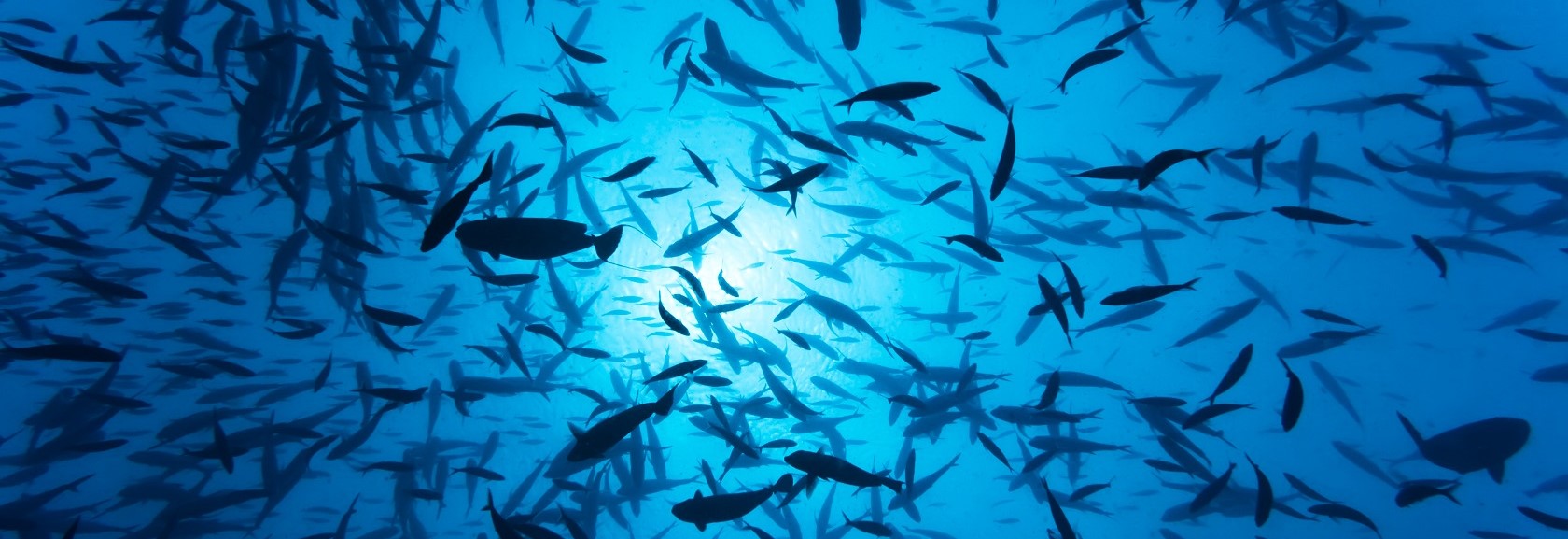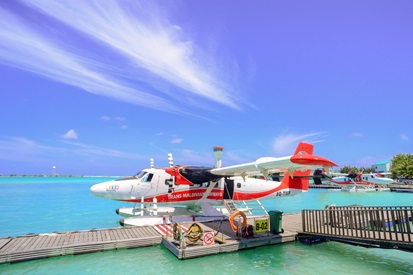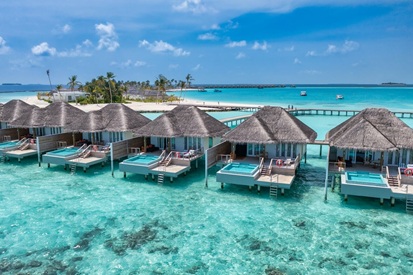

On the paradise islands, you can catch the best trophy of your life - blue marlin, tuna, or even a giant grouper. Or just go fishing under the night stars on a traditional dhoni boat. We have collected all the interesting things about fishing in the Maldives: who, where, and how to catch.

Hurawalhi Island Resort
When to Go to the Maldives for Best Fishing
You can fish in the Maldives all year round, and there are more than a thousand different species of fish in the Indian Ocean. But since the islands have two seasons, dry and wet, this affects temperature, water transparency, currents, and catch.
The best time to fish in the Maldives is from mid-November to April, when the dry season lasts. The weather during this time is stable, the sea is calm, and the water is especially clear. These are the perfect conditions to go out into the ocean and catch something truly impressive. Fish are particularly active in January and February, which is the peak season. At this time, schools of tuna, barracuda, dorado, and other predators approach the islands.
.jpg)
Hideaway Beach Resort & Spa Maldives
What to Catch in Different Months of the Year
- January. Clear water, calm sea. Great time to catch yellowfin tuna. Good catches include dorado, wahoo, sailfish, and marlin.
- February. Currents increase, but the sea remains calm. Excellent water visibility. Time for yellowfin tuna, dorado, barracuda, and grouper. Perfect conditions for trolling and night fishing.
- March. Plankton buildup begins. Many predatory fish, especially wahoo and tuna. Ideal time for ocean fishing. Barracuda and sailfish are caught. The tuna season continues.
- April. Transition from dry to rainy season. You can still catch tuna. Calm, but the weather can become more variable. Snappers and groupers are good catches.
- May. Beginning of the wet season (southwest monsoon). More rain and waves. Fish are active, especially tuna, but the sea is not always comfortable.
- June. Best time to catch giant trevally (on reefs, with poppers and jig baits). The rainy season is in full swing. Suitable for night fishing and shore fishing.
- July. Period of severe storms. Safe fishing only on reefs. Conditions are unstable but possible, especially in the evenings.
- August. Tuna, mahi-mahi, and wahoo. Good for snappers and tuna. Weather gradually improves. Barracuda, tuna, and groupers are caught. Fishing often takes place closer to the shore.
- September. Time for tuna, mahi-mahi, and wahoo. The sea calms down. Comfort for trolling returns.
- October. End of the rainy season. Lots of plankton, fish come close to the shore. Transitional month. Downpours are possible, but fishing improves. Groupers are good to catch.
- November. Start of the high season. The sea is calm, sailfish, marlin, and wahoo return. Good time for ocean fishing.
- December. Calm water, active predators. Ideal for fishing large species - marlin, sailfish, and tuna.

Depositphotos
Types of Fishing in the Maldives
The Maldives are the fishing capital. Until the 1970s-1980s, when tourism arrived in the Maldives, fishing was the main occupation. Today, this industry still holds a significant place in the country’s economy. The warm waters of the Indian Ocean boast immense biodiversity! You can fish in the Maldives in various ways:
- Shore Fishing. If you have little time, fishing directly from the shore is the best option. Check where fishing is allowed, as the Maldives takes marine conservation seriously. Shore fishing at Maldives resorts is generally prohibited without hotel permission. You’ll likely need to visit a small local island or an uninhabited island. The hotel will organize the trip.
- Night Fishing. You’ll set out after sunset to fish for nocturnal predators under the stars. These trips are organized on traditional dhoni boats, and you’ll fish with a rod. Your potential catch - emperors, snappers, squirrel fish, and jacks. Snappers and groupers are often caught.
- Trolling. This is how big fish like marlin, tuna, and wahoo are most often caught. Ideal for the dry season.
- Fly-fishing and Shallow Water Fishing. Suitable for those who want to catch barracuda or trevally near the shore.
- Charter Boat Fishing. For big game fishing or reef fishing, chartering a boat is the best option.
Consider a yacht with onboard accommodation. It’s a great way to explore different islands and their surrounding waters. Most such boats provide fishing licenses and gear.
Check with your hotel about fishing trips. Nearly every resort has a water sports center that can suggest safe routes, handle permits, and provide necessary equipment.

Anantara Kihavah Maldives Villas
What Fish Are Caught in the Maldives
The Maldives are one of the best places in the world for tropical fishing. You can catch very large specimens here. Barracuda, giant trevally, tuna, grouper, snapper, and marlin - you’ll find them all!
- Blue Marlin. Can weigh up to 300 kg. One of the most prized trophies in the Maldives. Caught mainly in the open ocean, especially in summer.
- Yellowfin Tuna. One of the most common yet largest species. Record specimens reach 100 kg. Caught year-round, especially from November to May. Tuna also attracts crowds of amateur anglers. One exciting aspect of tuna fishing is trying traditional Maldivian methods, such as rod and line fishing, a common practice here.
- Wahoo. A fast, aggressive fish, often caught during trolling. Maximum weight is about 45 kg.
- Mahi-mahi (Dorado, Dolphinfish). This beautiful fish can weigh up to 20-25 kg. Especially active during the monsoon season.
- Sailfish. Records up to 60-70 kg, though smaller specimens are more common. One of the ocean’s most beautiful inhabitants.
- Barracuda. A predator often caught near reefs. Specimens up to 30 kg are caught, especially with jigging or casting.
- Groupers and Snappers. Can be very large in bottom fishing - up to 15-20 kg, especially in southern atolls.
- Giant Trevally. The Maldives are one of the few places in the world where you can catch GT year-round, on reefs and shallows. Larger fish gather on reefs, making GT fishing a great opportunity to try popular Maldivian methods like jigging and popping. Smaller fish are found in shallows, where clear waters are ideal for targeted casts.
- Reef Fish. On reef excursions, you’ll mainly catch bottom fish like groupers, red emperor, smooth-lipped emperor, aventurine fish, squirrel fish, and jacks. Live bait and jigging are optimal for this.
- Several Types of Jacks. It’s not uncommon to catch various species, including big-eye jack, yellow-spotted jack, and black jack.

Meeru Island Resort & Spa
Fishing Equipment in the Maldives
Do you need to bring your own gear? Not necessarily. Most islands and hotels provide everything: rods, bait, and guides. But if you’re an experienced angler and prefer your own equipment, you can bring it along. Just check airline transportation rules. If you plan to use local gear, here’s what to expect:
- Rods and Tackle. Durable sea rods are used for trolling, jigging, and bottom fishing. Professional equipment from brands like Penn and Shimano is common.
- Reels. They are selected based on the type of fishing. For trolling, powerful multipliers are used; for jigging, high-speed spinning reels.
- Lures and Bait. Organizers provide artificial lures (wobblers, jigs, poppers) and live bait like small fish or squid.
- Equipment. Boats are equipped with life vests, gloves, and coolers for the catch. Some boats offer fishing chairs with mounts.
- Night Fishing. Special lanterns and light tackle are used for bottom fishing at night, mainly for snappers, groupers, and barracuda.

Kuredu Resort & Spa
What to Fish With in the Maldives
- Dhoni. A traditional Maldivian boat used for night fishing and near-shore trips. Stable, not the fastest, but the most romantic. You can fish as a pair, and later enjoy your catch prepared by local chefs at the hotel.
- Speedboat. Ideal for trolling and long ocean trips. Comfortable, equipped with GPS, sonar, sun canopy, refrigerator, and toilet.
- Specialized Fishing Yachts. Suitable for professional fishing and extended tours. They include cabins, showers, kitchens, and everything needed for multi-day fishing.

Vilamendhoo Island Resort & Spa
Fishing Spots in the Maldives: Where It Bites
You can fish almost anywhere in the Maldives, except in protected zones. However, certain spots offer better chances for a big catch, depending on the season, fish type, and depth. Pay special attention to these locations:
- Ari Atoll (South and North Ari Atoll). One of the most popular regions. Tuna, sailfish, mahi-mahi, and wahoo are often caught here. Known for clear water and convenient logistics - you can depart directly from the island.
- Malé Atoll (North and South Malé Atoll). If you’re staying near the airport or in the capital, you can still fish. Many affordable tours are available, especially for night bottom fishing.
- Faafu and Dhaalu Atolls. Less touristy, but perfect for secluded fishing. Great for jigging and reef fishing.
- Open Sea Beyond the Reefs. The largest predators - wahoo, tuna, and marlin - are caught outside the atolls. Boats and yachts designed for ocean trips are used for this.

Depositphotos
Fishing Records in the Maldives
Some charters in the Maldives hold unofficial tournaments with catch records and internal leaderboards. Hotels often display honor boards with photos of happy anglers and their trophies.
Although the IGFA (International Game Fish Association) database doesn’t record many world records from the Maldives, hundreds of unique specimens are caught here - not every tourist submits their catch officially. Among the largest catches:
- Black Marlin - 707.61 kg
- Atlantic Marlin - 581.51 kg
- Pacific Marlin - 624.14 kg
- Pacific Sailfish - 100.24 kg
- Swordfish - 536.15 kg

Depositphotos
How to Avoid a Fine: Fishing Rules in the Maldives
Maldivian laws are strict, and we strongly recommend adhering to them. Local authorities protect the islands’ natural resources with specific rules for anglers:
- Fishing on reefs with reserve status is strictly prohibited. For example, Baa Atoll, a UNESCO Biosphere Reserve, bans fishing from shore or boat. Violations incur fines of $500-2,000.
- Fishing on sandbanks or coral reefs forming islands is not allowed. If fishing near a hotel’s reef, you must obtain permission from the administration. Reefs over one kilometer from shore can be fished, but only at least 700 meters from the reef itself.
- Nets, spearguns, explosives, and any toxic substances are strictly prohibited.
- Catching or killing sharks, moray eels, or sea turtles - even if accidentally hooked - is forbidden.
- Fish caught during sport fishing are often released, especially rare or large species. Giant trevally and swordfish are typically caught following sport fishing principles.

Banyan Tree Vabbinfaru
Cost of Fishing in the Maldives
The most affordable option is traditional fishing from a dhoni boat. It’s popular among tourists wanting to try something new without high costs. You’re taken aboard with an instructor, given a line and hook, and head to the reefs. This trip lasts up to three hours and costs around $20 per person.
For more serious pursuits, like deep-sea fishing or trolling in the open ocean, expect higher costs. Renting a boat or yacht with full gear and an experienced crew averages $150 per hour. A half-day on the water can cost $500-1,000, depending on the vessel, route, and onboard services. Prices also vary by provider, as resort hotels often charge more. Costs for the same service can differ between suppliers:
- Night fishing on a dhoni. Cost: $50-160 per person. Duration: 2-3 hours.
- Morning fishing. Cost: from $150 per person. Duration: 2-3 hours.
- Big Game Fishing. 4 hours: from $600 per boat (up to 4 people).

Fairmont Maldives Sirru Fen Fushi
More articles
- Why you can be deported from Bali - several main reasons
- Seychelles hotels with the best panoramic views
- UNESCO sites in Indonesia: temples, parks and other amazing places
- Yogyakarta - all about the historic city of Java
- St. Anne Island in the Seychelles
- When to fly to Seychelles: prices and weather
- The best hotels in Kuta in Bali: 15 corners
- IHG Hotels & Resorts - 13 hotels in Bali
- Bali Retreat: Hotels and Deals
- The best excursions in the Seychelles - 11 ideas for impressions



